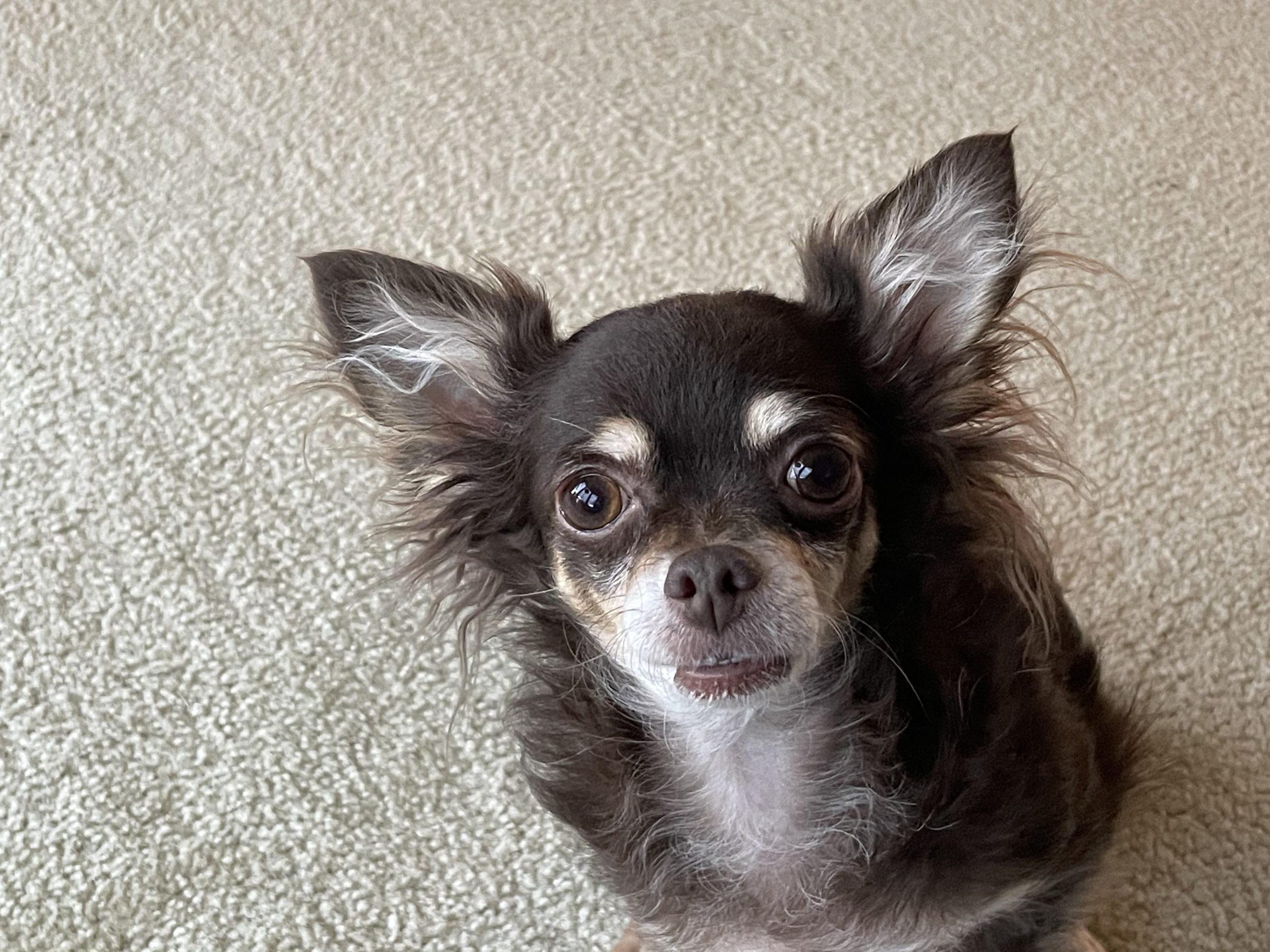A Game to Help a Barky Chihuahua Stop Reacting to Other Dogs
By: David Codr
Published Date: February 10, 2021
For this Omaha dog training session we helped Maya, a 7 year-old Chihuahua who likes to bark at other dogs.
Knowing that Maya was very barky around new people, I had some very high value training treats in my hand when I arrived for the session. I gave her a couple so she knew I had the goods, then started asking her to sit or lie down before giving her the treats. Within a minute or two she was relaxed and confident with my presence.
One of the tips that I shared with her guardian was to get Maya some exercise before guests arrive. This is an easy way to set a dog up for success. I also recommended the guardian have the guest give Maya a bully bite or a pre-prepared lick mat to create a positive association and occupy her.
While chatting with the guardian about Maya’s behavior, I noticed that just about anytime the dog demanded attention, the guardian started petting her, almost reflexively. And the few times that she did not start petting, Maya just jumped up into her lap to get that attention.
When I asked the guardian if Maya had any rules, it took her a couple minutes to realize that there were none in place. When a dog is able to get attention on demand, is not asked to wait for anything or get permission before getting what they want, it can cause them to become needy and in some case outright demanding.
I suggested that the guardian start asking Maya to sit before inviting her up on her lap. And if Maya jumps up in her lap without permission, to stand up immediately, then tell the dog to sit. If she does, then she can sit down and invite the dog into her lap. While there is nothing wrong with a dog jumping in your lap if you dont mind, asking the dog to ask for permission is an easy way to start establishinga healthy leader follower dynamic. This is going to be a challenge because both the human and the dog are in a habit of having Maya jump up into the lap. But if she is conscius about this for a week, Maya should start to sit to ask for permission.
I also went over my Petting with a Purpose strategy which is a different way of doing the same thing. The more Maya asks or does somehting for attention, the more she practices asking for things instead of demanding them. This is important for dogs who have difficulty controlling their emotions around other dogs.
I suggested a few other rules such as sitting before being let out the door, before preparing her food, etc.
One of my suggestions was to have the dog sit before a leash was attached, but the guardian said that Maya did not like the leash. I showed the guardian how she can use a conditioned emotional response or CER to help the dog get over her fear of the leash. Although the linked video is to help a dog get over a fear of the collar, the approach will work for a leash too. I recommended the guardian practice this exercise once a day for a week, going from room to room. Shouldn’t take long before the sight of the leash creates a happy emotion from Maya.
Once Maya is starting to lean towards or push it with her nose, then the guardian can start to go through the steps of attaching the leash. Holding the leash in one hand and then reaching a few inches towards the dog before pulling back and then offering a treat from her other hand. At first she will only reach out a few inches but after a few practices at that distance, she can reach a few additional inches.
If the guardian goes slow and watches for dog consent (stopping if Maya turns or lowers her head), she should be able to start attaching the leash and having the dog feel comfortable about it relatively quickly.
The main issue the guardian wanted help with was Maya’s habit of barking when she sees other dogs on walks. She also does this when the guardian visits her boyfriend’s home who also has a dog. I made sure to point out that she should not correct or disagree with a dog who barks at other dogs. Although this seems natural to humans, it can usually cause the dog to bark more intensely. If you want to stop a dog from barking, you need to make a positive association with the thing they are barking at. Correcting or disagreeing with the barking will never accomplish that.
I shared a number of other small tips to stop dog barking that will help such as distracting the dog before it gets a chance to bark or increasing the distance from any dogs she is barking at rather than trying to correct her. These are often overlooked tools used by dog behaviorists to put a stop to dog barking.
While these secrets to stopping dogs from barking at other dogs will help, I knew we needed to start creating positive associations around the arrival or visual of other dogs. I have found one of the easiest ways to stop dog barking at dogs is to practice the engage disengage game. Check out the free positive dog training video below if you want to learn how to teach your dog the engage disengage game to stop them from barking at other dogs.
The key to this trick to stop dogs from barking at other dogs is to make sure that you go slow. If you decrease the distance between the dogs too quickly, and your dog starts to bark at the other dog, all of the work that you did is really invalid. The dog has to be calm, relaxed and not bark the entire time you practice.
The guardian will need to go slowly and keep track of the distance she was at each time she practices. This will help her know what distance to start at the next time (although there is sometimes regression which is normal). It will also be imprtant to remember that any time that Maya stops showing interest in treats or has difficulty sitting down, that is an indication she’s getting close to her limit and is about to start barking.
If you go slow and steady and practice without the dog barking at all, eventually you can get close enough for those dogs to start to go on walks together; another suggestion that I made for Maya with her boyfriend‘s dog. That suggestion may need to be tabled temporarily because of the extreme cold outside and the negative impact it can have on Chihuahuas due to the poor circulation in their feet. But having dogs walk together, even if they have to be quite far apart at first, is an outstanding way to help dogs stop reacting to other dogs. It builds up a positive shared experience that leads to better behavior.
While many people do not see the correlation, adding rules and structure and helping the dog practice self-control at home can go a long ways towards helping stop a dog barking problem.
To help the guardian remember all of the positive dog training tips we shared in this in-home Omaha dog training session, we filmed a roadmap to success summary video that you can check out below.
Categorized in: Dog Behavior


